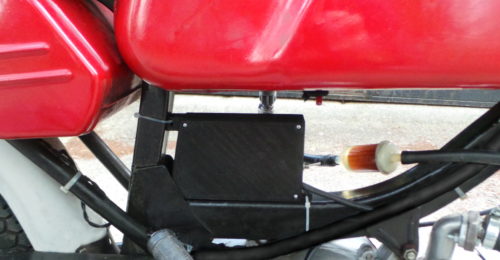“Some projects are made for a money, some because they make sense. Some simply because they are so faraway from both.”
Jawa 20, 21, 23 – Pioneer, Pincek, Fichtl, Feek or Fecal. Likely the most affordable vehicle in the Czech (and Slovak) Republic. Although it is now a veteran, it is omnipresent and, with some luck, it can be purchased for the price of refueling a car. Thanks to naive simplicity of it’s construction it became a cult, and also a very popular platform for various (sometimes slightly crazy) DIY improvements. Since I am a owner of one such bike and since I am a fan of crazy DIY improvements, I decided to slightly improve on-board electronics and confront my more than 43 years old motorcycle with 21st century.
The main focus was on the dashboard and controls of decrepit Jawa. Original dashboard is here represented by the area where is located tachometer (works on about 1% machines) and massive rotary switch, which sometimes manage to turn on the lights. The switch also lets you make the cleanest shutdown of the engine, if it does not stop spontaneously. Another control elements of Fichtl are represented by several other mechanical switches, which in the matter of fact serves for generating of a random transitional resistance somewhere from 1Ohm to infinity. These sources of random control signals are connected to horn (which does not matter because horn works on about 0.01% machines) and to main beam headlight (light works, following the random controlling states properly). Overall, the bike’s circuitry is minimalistic, and contains no active electronics. So a new ground to break…
The aim of the project was to create an OLED touchscreen dashboard, similar to one in the Tesla Model S (although of course smaller). All shoddy mechanical switches are replaced by virtual buttons on the touchscreen. Diagnostic informations about the vehicle should be displayed on a 3D model of the vehicle with highlighting the specific problem – similar to probably Voyager from Star Trek … something like that was probably in every other sci-fi. It was also necessary to create a good serviceable storage space for all of added electronics. There is no such existing space on the Fichtl because simply there in no any electronics.

Java on Jawa
There was only about 7 days for the realization of the project. Firstly, that much time was remaining to a massive Fichtl meeting in Vselibice and secondly I would hardly be able to found more time for such foolhardy project. There was therefore not quite space for a clear technical solutions and custom PCBs. Dashboard is a mere smartphone with Android in 3D printed ABS housing. Only interesting work to do was to write a control software in Java. Since I’m quite a friend with the Android and OpenGL ES for a few years this was matter of about two or three days (I’ve had a 3D model of Fichtl already). Loading and viewing of the 3D model and whole dashboard is based on the latest release of the libGDX. Communications of new electronics and smartphone is using bluetooth.

It can be noticed that the 3D model is representing the wrong type of Jawa. The 3D model is Jawa 21 while the real bike is Jawa 23. I used to own Type 21 before and the 3D model is simply from that time. Dashboard is now measuring only the engine RPM, there is nevertheless preparation for the tachometer, engine temperature measurement and fuel level status. Virtual keys can be used to control the lights, horn and engine stopping.
Blackbox
The room for added electronics is provided by 3D printed box, this time created from PLA material. The box can be mounted quite noninvasively – just two cable ties. A cover of the box can be easily removed when some service tasks (eg. battery check ) need to be performed.)

The box contains a Li-pol battery, Arduino mini, bluetooth module, board with relays, switching, regular and some custom electronics for sensing the motor RPM from the primary winding of the ignition coil. The electronics inside the box is galvanically isolated from the rest of the bike’s circuitry (with help of relays and optocouplers). On the side of the box is placed the main switch.
When I have some time I will advance the project and I will finish the speed measurement, fuel level measurement, alarm and some other diagnostic functions. I would also like to add control of whole system by the smart watches. After all, Tesla Model S has this, and I’m not willing to stay behind…
Nice! Can I have this on my Honda CBR? 🙂
I honestly don’t know anything about Honda CBR wiring. But with some effort I guess yes… it would be probably easier than with Fichtl 🙂